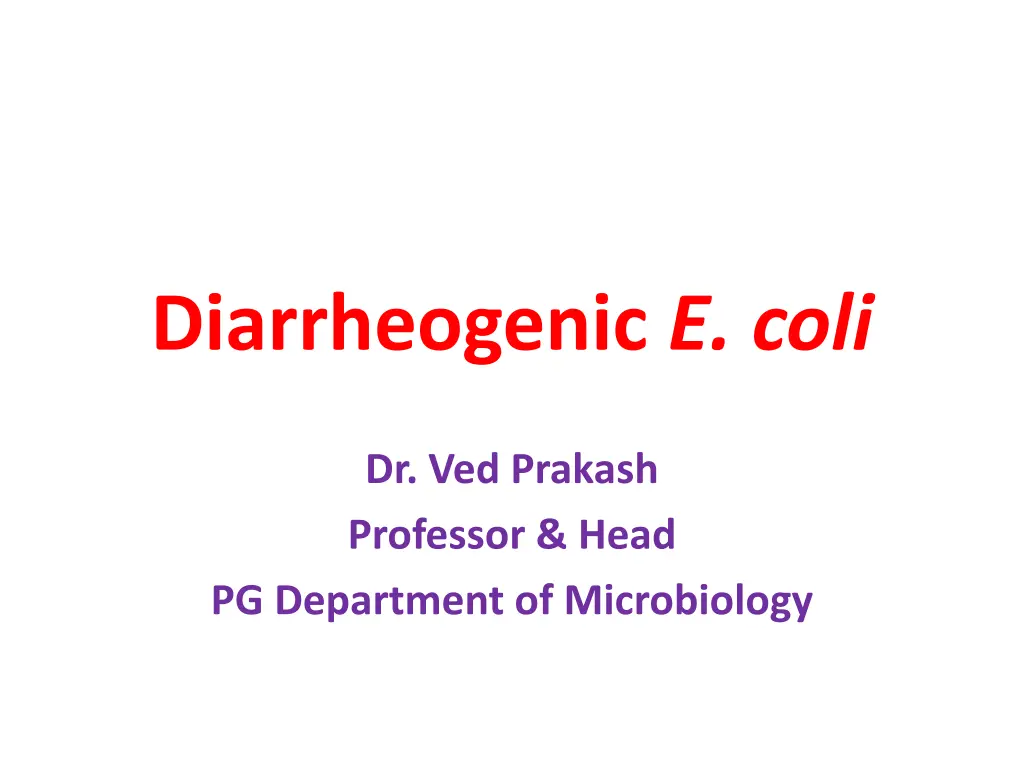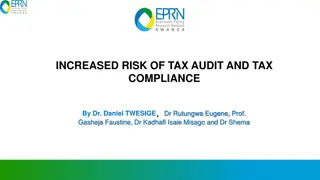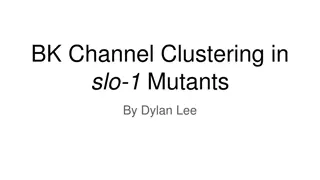
E.coli Infections: Types, Symptoms, and Mechanisms Explained
Learn about different pathotypes of diarrheogenic E.coli, their distinct characteristics, mechanisms causing diarrhea, and the global impact of E.coli infections. Understand the importance of diagnosis and treatment strategies to combat this common health issue.
Download Presentation

Please find below an Image/Link to download the presentation.
The content on the website is provided AS IS for your information and personal use only. It may not be sold, licensed, or shared on other websites without obtaining consent from the author. If you encounter any issues during the download, it is possible that the publisher has removed the file from their server.
You are allowed to download the files provided on this website for personal or commercial use, subject to the condition that they are used lawfully. All files are the property of their respective owners.
The content on the website is provided AS IS for your information and personal use only. It may not be sold, licensed, or shared on other websites without obtaining consent from the author.
E N D
Presentation Transcript
Diarrheogenic E. coli Dr. Ved Prakash Professor & Head PG Department of Microbiology
Diarrhea (Diarrheagenic E. coli) Antigenically distinct from the commensal E. coli which colonize the intestine. Only few serotypes of E. coli which express the enterotoxin or other virulence mechanisms can cause diarrhea. WHO estimated that >300 million illnesses and nearly 200,000 deaths are caused by diarrheagenic E. coli globally each year There are six pathotypes of diarrheagenic E. coli. 2
Enteropathogenic E. coli (EPEC) EPEC frequently causes infantile diarrhea (outbreaks) and occasionally cause sporadic diarrhea in adults. Person-to-person spread is seen Nontoxigenic and noninvasive 3
Enteropathogenic E. coli destruction of surface microvilli fever diarrhea vomiting nausea non-bloody stools (not generally seen as dysentery) Gut lumen 4
Mechanism of diarrhea includes: Adhesion to intestinal mucosa, mediated by plasmid coded bundle-forming pili, which form cup-like projections called pedestals. A/E lesions (attaching and effacing lesions): Typical lesions produced on the intestinal epithelium - leads to disruption of brush border epithelium causing increased secretion and watery diarrhea. 5
Enterotoxigenic E. coli (ETEC) ETEC is the most common cause of traveler s diarrhea causing 25 75% of cases. It causes acute watery diarrhea in infants and adults It is toxigenic, but not invasive 7
ETEC adhere to small bowel enterocytes and induce watery diarrhoea by the secretion of heat-labile (LT) and/or heat-stable (ST) enterotoxins. 8
Pathogenesis of ETEC is by: Attachment to intestinal mucosa is mediated by fimbrial protein called CFA (colonization factor antigen) Toxin production (1) heat-labile toxin (acts by cAMP), (2) heat-stable toxin (acts by cGMP). Diagnosis: Detection of toxins is the mainstay of diagnosis 9
Enteroinvasive E. coli (EIEC) EIEC is biochemically, genetically and pathogenically closely related to Shigella. Pathogenesis: EIEC is not toxigenic, but invasive. The epithelial cell invasion is mediated by a plasmid-coded antigen called virulence marker antigen (VMA) 10
Enteroinvasive E. coli (EIEC ) Dysentery - resembles shigellosis Gut lumen 11
EIEC invades the colonic epithelial cell, lyses the phagosome and moves through the cell by nucleating actin microfilaments. The bacteria might move laterally through the epithelium by direct cell-to-cell spread or might exit and re-enter the baso-lateral plasma membrane. 12
Manifestations: Ulceration of bowel, dysentery (diarrhea with mucus and blood, called bacillary dysentery resembling shigellosis) Diagnosis: Detection of VMA by ELISA HeLa cell invasion assay Biochemically atypical being nonmotile, and lactose nonfermenters. 13
Enterohemorrhagic E. coli (EHEC) EHEC is prevalent mainly in industrialized countries. Serotypes associated with EHEC: O157:H7 is the most common serotype. However other strains may account for up to 50% of EHEC infections; among which O104:H4 strain of EAEC is important 14
EHEC also induce the attaching and effacing lesion, but in the colon. The distinguishing feature of EHEC is the elaboration of Shiga toxin (Stx), systemic absorption of which leads to potentially life-threatening complications. 15
Transmitted by contaminated food, i.e. consumption of lettuce, spinach, sprouts and undercooked ground beef. The recent outbreak of EHEC (in 2020), was reported in United States, was due to consumption of clover sprouts contaminated with E. coli O103 Low infective dose: Only few organisms (<102 bacilli) are required to initiate the infection 16
Pathogenesis: EHEC secretes a toxin called verocytotoxin or Shiga toxin; therefore - called Shiga toxin producing E. coli (STEC) Resembles with Shiga toxin produced by Shigella dysenteriae type 1 Acts by inhibiting the protein synthesis by inhibiting 60S ribosome. It is of two types Stx1 and Stx2. 17
Manifestations: Shiga toxin has a predilection for endothelial cells causing capillary microangiopathy which leads to: HC (hemorrhagic colitis) Hemorrhagic uremic syndrome (HUS) 18
Diagnosis: Special culture media - Sorbitol MacConkey agar (does not ferment sorbitol) and Rainbow agar are used for EHEC Toxin detection: Demonstration of cytotoxicity in Vero cell lines (gold standard method) Fecal toxin detection by ELISA or rapid tests. 19
Enteroaggregative E. coli (EAEC) So named because it adheres to HEp-2 cells in a distinct pattern, layering of the bacteria aggregated in a stackedbrick fashion. Most strains are O untypeable but H typeable. 20
i. EAEC adheres to small and large bowel epithelia in a thick biofilm and elaborates secretory enterotoxins and cytotoxins. Shortening of microvilli, mononuclear infiltration and Haemmorhage. 21
Pathogenesis: Intestinal colonization is mediated by aggregative adhesion fimbriae I (regulated by aggR gene) It also produces EAST 1 toxin (enteroaggregative heat stable enterotoxin 1). 22
Manifestations: Persistent and acute diarrhea are commonly seen; especially in developing countries - can also cause traveler s diarrhea and persistent diarrhea in infants Diagnosis is made by - (i) detection of aggR and aatA gene by PCR, and (ii) HEp-2 adherence test (gold standard). 23
E. coli O104: H4 It is an enteroaggregative strain that has caused major outbreaks in Germany in 2011. One peculiar feature of this strain is, it produces Shiga toxin and can cause HUS. 24
Diffusely-adherent E. coli (DAEC) Ability to adhere to HEp-2 cells in a diffuse pattern Expresses diffuse adherence fimbriae which contribute to the pathogenesis DAEC is capable of causing diarrheal disease, primarily in children aged 2 6 years. 25
Treatment of Diarrheagenic E. coli The mainstay of treatment is fluid replacement - use of antimicrobials should generally be avoided. The following are the situations where antibiotics may be considered. Traveler s diarrhea (ETEC or EAEC) EIEC EHEC and E. coli O104: H4 EAEC 26
Travelers diarrhea (ETEC or EAEC): Only for severe traveler s diarrhea, azithromycin is indicated. Rifaximin, an oral nonabsorbable antibiotic can also be given EIEC: Although the infection is self-limited, antibiotics such as azithromycin is indicated as it fastens the recovery, particularly in severe cases 27
EHEC and E. coli O104: H4: Cotrimoxazole, beta-lactams, metronidazole should be avoided as they precipitate HUS. If treatment has to be started (e.g. if positive blood culture), azithromycin is the preferable option EAEC: Only in immunocompromised patients, ciprofloxacin for 3-7 days is recommended. 28
Causative agents of infective diarrhea A. Bacteria C. Protozoa Vibrio cholerae Entamoeba histolytica V.Parhaemolyticus Giardia lamblia Escherichia coli (ETEC, EPEC) Cryptosporidium parvum Salmonella Enteritidis Isospora belli S.Typhimurium D. Cestodes Other Salmonella sp. Hymenolepis nana Campylobacter sp. E.Nematodes Yersinia enterocolitica Trichuris trichiura Shigella sp. Strongyloides stercoralis Clostridium perfringens Ascaris lumbricoides C.Difficile Hookworms Staphylococcus aureus F. Trematodes Bacillus cereus Schistosoma mansoni Aeromonas hydrophilia
Plesiomonas shigelloides B. Viruses Rotavirus Astrovirus Calicivirus Norwalk virus Adenovirus
Types of bacterial diarhea i. Invasive bacterial pathogens Salmonella species Shigella species Enteroinvasive Esch. Coli (EIEC) Enterohemorrhagic Esch. Coli (EHEC) Vibrio Parhaemolyticus Campylobacter jejuni Yersinia enterocolitica ii. Noniasive bactrial pathogens These organisms cause gastroenteritis or food poisoning by production of toxin. Enterotoxigenic Esch. Coli (ETEC) Enteropathogenic Esch. Coli (EPEC) Vibrio cholerae Shigella dysentriae tpe1 Staphylococus aereu Bacillus cereus Clostridiu perfringens Clostridum difficile
Microbial agents of food poisoning Organisms Symptoms Common food sources 1 6 h incubation period Vomiting, diarrhea, abdominal cramps Ham, poultry, salad, mayonnaise, pastries, dairy products Staphylococcus aureus Vomiting, diarrhea, abdominal cramps Bacillus cereus Fried rice 8 16 h incubation period Beef, poultry, legumes, gravies Clostridium perfringens Abdominal cramps, diarrhea Meats, vegetables, dried beans, cereals B. cereus Abdominal cramps, diarrhea 32
Organisms Symptoms Common food sources >16 h incubation period Vibrio cholerae Watery diarrhea Shellfish, water Enterotoxigenic E. coli Watery diarrhea Salads, cheese, meat, water Enterohemorrhagic E. coli Ground beef, salami, milk, raw vegetables, apple juice Bloody diarrhea Non-typhoidal salmonellae Inflammatory diarrhea Meat, eggs, milk, juice, raw fruits and vegetables Potato, egg salad, lettuce, raw vegetables Shigella species Dysentery Vibrio parahaemolyticus Raw or undercooked shellfish, particularly oysters Dysentery 33
Organisms Symptoms Common food sources >16 h incubation period Campylobacter jejuni Inflammatory diarrhea Poultry, raw milk or water Flaccid paralysis, diplopia, dysphagia Homemade improperly canned food, and honey (infants) Clostridium botulinum Fever and myalgia (pregnant women) Watery diarrhea, vomiting, abdominal cramps Watery diarrhea, abdominal cramps Depends on type of fungal toxins, e.g. aflatoxin- causes hepatoma Soft cheeses, raw sprouts, meats, seafood, and milk Salads, fresh fruits, shellfish (such as oysters), or water Raw fruits or vegetables and herbs Nuts, maize, wheat, cereals, etc. Listeria monocytogenes Norovirus Cyclospora Mycotoxicoses (6-24h) 34
Treatment of Food poisoning The mainstay of treatment is adequate rehydration and electrolyte supplementation - either an oral rehydration solution (ORS) or intravenous solutions (e.g. isotonic sodium chloride solution, Ringer lactate solution). Other symptomatic treatment - absorbents (e.g. aluminum hydroxide) and antisecretory agents (e.g. bismuth subsalicylate) 35
Antitoxin such as heptavalent botulism equine serum antitoxin can be given if food botulism is suspected Antibiotics - penicillin or metronidazole may be attempted for botulism Diet: During episodes of acute diarrhea, patients often develop an acquired disaccharidase deficiency due to washout of the brush-border enzymes - avoiding milk, dairy products, and other lactose-containing foods are advisable 36
Antibiotics: Usually antibiotics do not play much role. It is mainly indicated for shigellosis, where fluoroquinolone (e.g. ciprofloxacin) is the first- line agent. In suspected cholera, azithromycin is the drug of choice. 37
CHEMICAL CAUSES OF FOOD POISONING There are several non-microbial agents that can cause food poisoning such as capsaicin (found in hot peppers), variety of toxins found in fish and shellfish, ciguatera, histaminefish poisoning (scombroid), and some chemical poisons (e.g. heavy metals). 38
Scombroid Food Poisoning Morganella morganii, a commensal in sea fish can breakdown histidine present in sea fish into histamine, which can cause food poisoning following seafood intake. Proper storage of fish in freezer (<16 C) can prevent this condition. It is a gram-negative bacillus, belongs to Enterobacteriaceae family. 39
MYCOTOXICOSES Mycotic poisoning is a rare cause of food poisoning, caused by fungi. The disease can be classified into two varieties: 1. Mycotoxicosis: Disease produced by consumption of food contaminated with toxins liberated by certain fungi 2. Mycetism: Toxic effects produced by eating poisonous fleshy fungi; usually different types of mushrooms. 40
Features of common mycotoxicosis Produced by fungal species Aspergillus flavus Aspergillus parasiticus, A. nomius Penicillium puberulum Fusarium moniliforme Mycotoxin Source Clinical condition Nuts, maize Hepatoma,hepatitis Indian childhood cirrhosis Reye s syndrome Aflatoxin Equine leukoencephalomalacia Porcine pulmonary edema Carcinoma esophagus Fumonisins Maize Alimentary toxic aleukia Biological warfare (yellow rain) Maize, wheat, sorghum Trichothecenes Fusarium graminearum 41
Mycotoxin Produced by fungal species Source Clinical condition Ochratoxin Aspergillus ochraceus, Cereals, bread Nephropathies A. niger Penicillium (Balkan endemic verrucosum nephropathy) Kodua poisoning Cyclopiazonic Aspergillus flavus, A. Groundnut, corn Co-contaminant acid versicolor, A. oryzae Penicillium cyclopium with aflatoxin Zearalenones Fusarium graminearum Wheat, maize Genital disorder in pigs 42
Features of common mycetism Mushroom Produced by fungal Source Clinical condition poisoning species Ergot alkaloid Claviceps Rye flour St. Anthony s fire purpurea Coprine poisoning Coprine Butter Antabuse like reaction atramentarius Muscarine Inocybe fastigiata Food Cholinergic effect Ibotenic acid, Amanita Edible Abdominal pain, muscimol pantherina mushroom vomiting, diarrhea Cyclopeptide Amanita Edible Hepatocellular failure, phalloides mushroom green death cap 43





